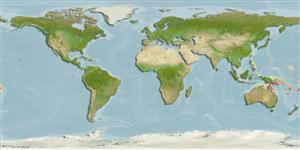Actinoptérygiens (poissons à nageoires rayonnées) >
Perciformes (Perch-likes) >
Plesiopidae (Roundheads) > Plesiopinae
Etymology: Assessor: Latin, assessor, -oris = the person that tkes part in some play.
Environnement / Climat / Gamme
Écologie
; marin récifal; profondeur 5 - 20 m (Ref. 9710), usually 5 - 20 m (Ref. 27115). Tropical; 24°C - 26°C (Ref. 27115), preferred ?
Western Central Pacific: Great Barrier Reef and Papua New Guinea.
Taille / Poids / Âge
Maturity: Lm ? range ? - ? cm
Max length : 6.0 cm TL mâle / non sexé; (Ref. 90102)
Épines dorsales (Total): 11; Rayons mous dorsaux (Total): 8-10; Épines anales 3; Rayons mous anaux: 9 - 10.
Found near reefs (Ref. 7300). In aggregations in caves, often upside down. Males incubate the egg mass in their mouths (Ref. 9710). Also found in caves, crevices and under ledges (Ref 90102).
Life cycle and mating behavior
Maturité | Reproduction | Frai | Œufs | Fécondité | Larves
Eggs are guarded by the male parent (Ref. 205).
Paxton, J.R., D.F. Hoese, G.R. Allen and J.E. Hanley, 1989. Pisces. Petromyzontidae to Carangidae. Zoological Catalogue of Australia, Vol. 7. Australian Government Publishing Service, Canberra, 665 p. (Ref. 7300)
Statut dans la liste rouge de l'IUCN (Ref. 115185)
CITES (Ref. 94142)
Not Evaluated
Menace pour l'homme
Harmless
Utilisations par l'homme
Aquarium: Commercial
Plus d'informations
RéférencesAquacultureProfil d'aquacultureSouchesGénétiqueFréquences alléliquesHéritabilitéPathologiesTraitementMass conversion
CollaborateursImagesStamps, CoinsSonsCiguateraVitesseType de nageSurface branchialeOtolithesCerveauxVision
Outils
Articles particuliers
Télécharger en XML
Sources Internet
